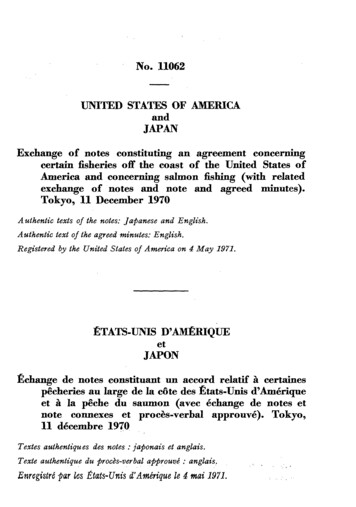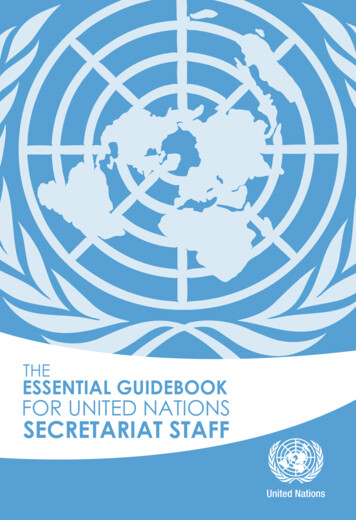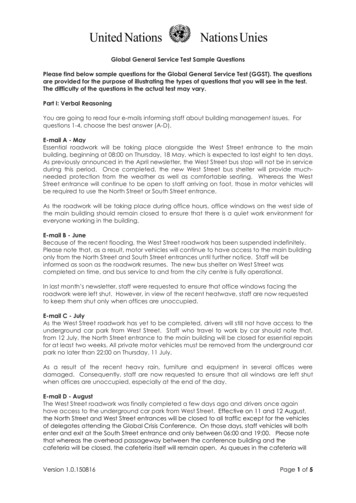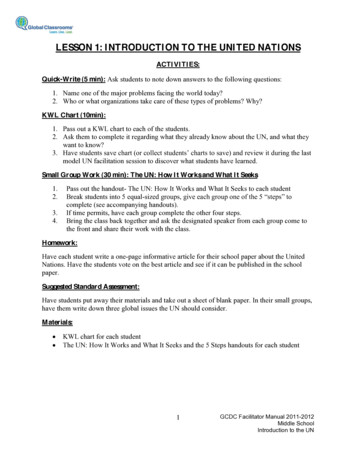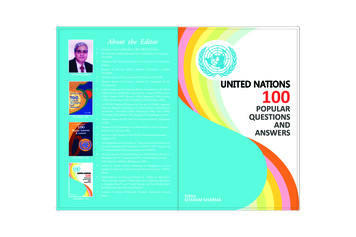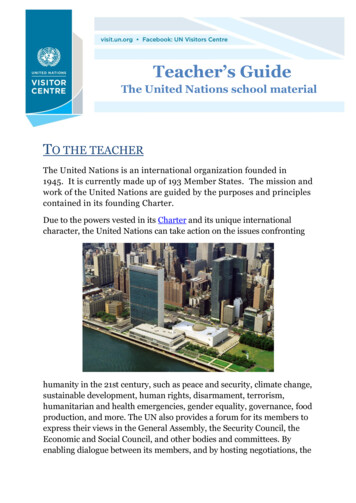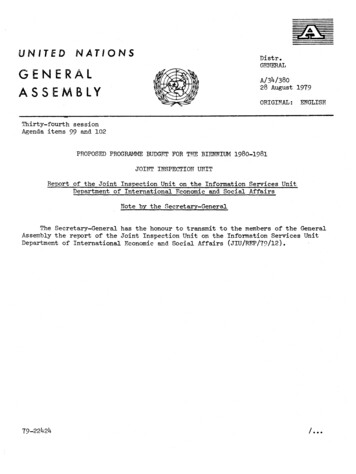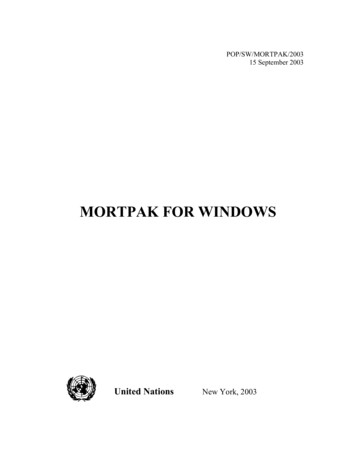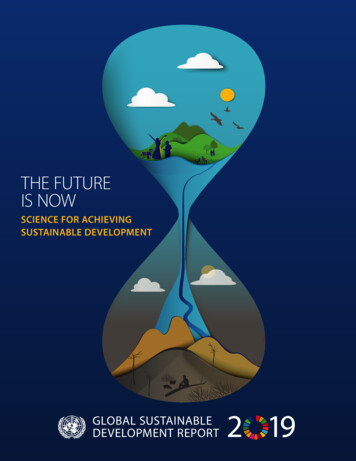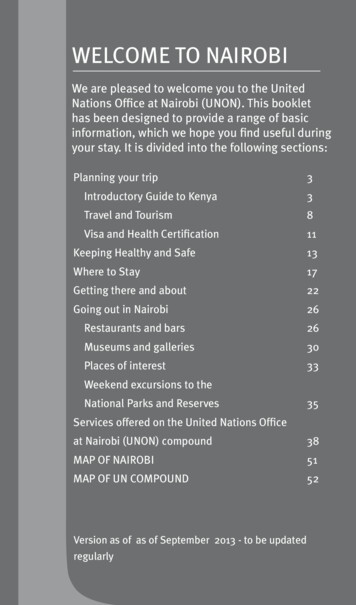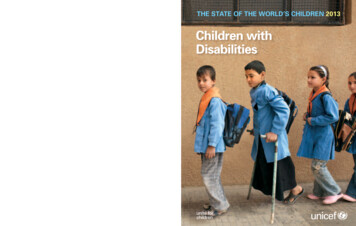
Transcription
THE STATE OF THE WORLD’S CHILDREN 2013United Nations Children’s Fund3 United Nations PlazaNew York, NY 10017, USAEmail: pubdoc@unicef.orgWebsite: www.unicef.orgTHE STATE OF THE WORLD’S CHILDREN 2013XX%Cert no. XXX-XXX-XXXUS 25.00ISBN: 978-92-806-4656-6eISBN: 978-92-806-4662-7United Nations publication sales no.: E.13.XX.1 United Nations Children’s Fund (UNICEF)May 2013CHILDREN WITH DISABILITIESTo read this report online,scan this QR code or go towww.unicef.org/sowc2013Children withDisabilities
United Nations Children’s Fund (UNICEF)May 2013Permission is required to reproduce any part of this publication. Permission will befreely granted to educational or non-profit organizations. Others will be requestedto pay a small fee. Please contact:Division of Communication, UNICEFAttn: Permissions H6F3 United Nations Plaza, New York, NY 10017, USATel: 1 (212) 326-7434Email: nyhqdoc.permit@unicef.orgThis report and additional online content are available at www.unicef.org/sowc2013 . Perspective and Focus essays represent the personal views ofthe authors and do not necessarily reflect the position of the United NationsChildren’s Fund.For corrigenda subsequent to printing, please see www.unicef.org/sowc2013 .For latest data, please visit www.childinfo.org .ISBN: 978-92-806-4656-6eISBN: 978-92-806-4662-7United Nations publication sales no.: E.13.XX.1Cover photo:Schoolchildren queue to enter their classroom in this 2007 photograph from theSyrian Arab Republic. UNICEF/HQ2007-0745/NooraniUNICEF HeadquartersUNICEF House3 United Nations PlazaNew York, NY 10017, USAUNICEF Latin America andthe Caribbean Regional OfficeP.O. Box 0843-03045Panama City, PanamaUNICEF Regional Office for EuropePalais des NationsCH-1211 Geneva 10, SwitzerlandUNICEF East Asia and PacificRegional OfficeP.O. Box 2-154Bangkok 10200, ThailandUNICEF Central and Eastern Europe/Commonwealth of IndependentStates Regional OfficePalais des NationsCH-1211 Geneva 10, SwitzerlandUNICEF Eastern and Southern AfricaRegional OfficeP.O. Box 44145Nairobi, Kenya 00100UNICEF West and Central AfricaRegional OfficeP.O. Box 29720, YoffDakar, SenegalUNICEF Middle East and North AfricaRegional OfficeP.O. Box 1551Amman 11821, JordanUNICEF South Asia Regional OfficeP.O. Box 5815Lekhnath MargKathmandu, Nepal
THE STATE OF THEWORLD’S CHILDREN 2013
ACKNOWLEDGEMENTSThis report is the result of collaboration among too many individuals and institutions to acknowledge here. The editorial and research teamthanks all who gave so willingly of their time, expertise and energy, in particular:Vesna Bosnjak (International Social Services); Shuaib Chalklen (UN Special Rapporteur on Disability); Maureen Durkin (University of Wisconsin); Nora Groce and Maria Kett(Leonard Cheshire Disability and Inclusive Development Centre, University College London); Nawaf Kabbara (Arab Organization of Disabled People); Lisa Jordan (Bernardvan Leer Foundation); Connie Laurin-Bowie (International Disability Alliance); Barbara LeRoy (Wayne State University); Charlotte McClain-Nhlapo (United States Agency forInternational Development); Helen Meekosha (Women with Disabilities Australia); Peter Mittler (University of Manchester); Roseweter Mudarikwa (Secretariat of the AfricanDecade on Persons with Disabilities); David Mugawe (African Child Policy Forum); Ghulam Nabi Nizamani (Pakistan Disabled Peoples’ Organization); Victor Santiago Pineda(Victor Pineda Foundation); Tom Shakespeare (World Health Organization); Aleksandra Posarac (World Bank); Shantha Rau Barriga (Human Rights Watch); Eric Rosenthal(Disability Rights International); Albina Shankar (Mobility India); and Armando Vásquez (Pan American Health Organization) for serving on the External Advisory Board.Judith Klein (Open Society Foundations); Gerrison Lansdown (independent); Malcolm MacLachlan and Hasheem Mannan (Trinity College Dublin); Susie Miles (independent);Daniel Mont (Leonard Cheshire Disability); and Diane Richler (International Disability Alliance) for authoring background papers.Sruthi Atmakur (City University of New York); Parul Bakshi and Jean-Francois Trani (Washington University in St. Louis); Nazmul Bari and Amzad Hossain (Centre for Disabilityin Development); Simone Bloem and Mihaylo Milovanovitch (Organization for Economic Co-operation and Development); Johan Borg (Lund University); Megan Burke,Stephane De Greef and Loren Persi Vicentic (Landmine and Cluster Munition Monitor); James Conroy (Center for Outcome Analysis); Audrey Cooper, Charles Reilly and AmyWilson (Gallaudet University); Alexandre Cote (International Disability Alliance); Marcella Deluca, Sunanda Mavillapalli, Alex Mhando, Kristy Mitchell, Hannah Nicolls andDiana Shaw (Leonard Cheshire Disability/Young Voices); Avinash De Souza (De Souza Foundation); Catherine Dixon (Handicap International); Fred Doulton (Secretariat of theConvention on the Rights of Persons with Disabilities); Natasha Graham (Global Partnership for Education); Jean Johnson (University of Hawaii); Chapal Khasnabis and AlanaOfficer (World Health Organization); Darko Krznaric (Queen’s University); Gwynnyth Llewellyn (University of Sydney); Mitch Loeb (Centers for Disease Control and Prevention/National Center for Health Statistics); Rosemay McKay (Australian Agency for International Development); Amanda McRae (Human Rights Watch); Sophie Mitra (FordhamUniversity); David Morissey, Sherzodbek Sharipoo and Andrea Shettle (United States International Council on Disabilities); Zelda Mycroft (The Chaeli Campaign); EmmaPearce (Women’s Refugee Commission); Natalia Raileanu (Keystone Human Services); Richard Rieser (World of Inclusion); Marguerite Schneider (Stellenbosch University);Morsheda Akter Shilpi (Organization for the Poor Community Advancement); Silje Vold (Plan Norway) for writing background material or providing advice and information.Tracy Achieng; Grace Okumu Akimi; Sophia Rose Akoth; Abeida Onica Anderson; Washinton Okok Anyumba; Beatrice Atieno; Ssentongo Deo; Ivory Duncan; Argie Ergina;Mary Charles Felix; Michael Salah Hosea; Amna Hissein Idris; Tiffany Joseph; Hannah Wanja Maina; Saitoti Augustin Maina; Dianne Mallari; Modesta Mbijima; ShidaMganga; Nicole Mballah Mulavu; Joseph Kadiko Mutunkei; Ann Napaashu Nemagai; Rachael Nyaboke Nyabuti; Alice Akoth Nyamuok; Sarah Omanwa; Benson Okoth Otieno;Nakafu Phiona; Shalima Ramadhani; Rosemarie Ramitt; Nambobi Sadat; Veronicah Shangutit Sampeke; Ladu Michel Seme; Josephine Kiden Simon; Muhammad Tarmizi binFauzi; Elizabeth Mamunyak Tikami; Shemona Trinidad; and the 20 other young people who participated anonymously in surveys and focus groups conducted specially for thisreport by facilitators from the Leonard Cheshire Disability Young Voices network.Bora Shin and Matthew Manos (veryniceDesign) for the infographic on universal design published online at www.unicef.org/sowc2013 .UNICEF country and regional offices and headquarters divisions contributed to this report or to related online content or advocacy materials by submitting findings or photographs, taking part in formal reviews or commenting on drafts. Many UNICEF offices and national committees arranged to translate or adapt the report for local use.Programme, policy, communication and research advice and support were provided by Yoka Brandt, Deputy Executive Director; Geeta Rao Gupta, Deputy Executive Director;Gordon Alexander, Director, Office of Research and colleagues; Nicholas Alipui, Director, Programme Division and colleagues; Ted Chaiban, Director, Office of EmergencyOperations and colleagues; Colin Kirk, Director, Office of Evaluation and colleagues; Jeffrey O’Malley, Director, Division of Policy and Strategy and colleagues; and EdwardCarwardine, Deputy Director, Division of Communication and colleagues. This edition also benefited from the close cooperation of Rosangela Berman-Bieler, Chief, andcolleagues in the Disability Section of UNICEF’s Programme Division.Special thanks to David Anthony, Chief, Policy Advocacy Section; Claudia Cappa, Statistics and Monitoring Specialist; Khaled Mansour, Director of Communication untilJanuary 2013; and Julia Szczuka, deputy editor of this report until September 2012, for their generosity of intellect and spirit.REPORT TEAMEDITORIAL AND RESEARCHPUBLISHING AND DISSEMINATIONAbid Aslam, EditorChristine Mills, Project ManagerNikola Balvin, Sue Le-Ba, Ticiana Maloney, Research OfficersAnna Grojec, Perspectives EditorMarc Chalamet, French EditorCarlos Perellon, Spanish EditorHirut Gebre-Egziabher (Lead), Lisa Kenney, Ami Pradhan, Research AssistantsCharlotte Maitre (Lead), Carol Holmes, Pamela Knight, Natalie Leston,Kristin Moehlmann, Copy EditorsAnne Santiago, Nogel S. Viyar, Judith Yemane, Editorial supportCatherine Langevin-Falcon, Chief, Publications Section; Jaclyn Tierney, ProductionOfficer; Germain Ake; Christine Kenyi; Maryan Lobo; Jorge Peralta-Rodriguez;Elias SalemSTATISTICAL TABLESTessa Wardlaw, Associate Director, Statistics and Monitoring Section, Divisionof Policy and Strategy; David Brown; Claudia Cappa; Liliana Carvajal; ArchanaDwivedi; Anne Genereux; Elizabeth Horn-Phathanothai; Priscilla Idele; ClaesJohansson; Rouslan Karimov; Rolf Luyendijk; Colleen Murray; Jin Rou New;Holly Newby; Khin Wityee Oo; Nicole Petrowski; Tyler Porth; Chiho Suzuki;Andrew Thompson; Danzhen YouDesign by Prographics, Inc.Printed by Hatteras Press, Inc.iiTHE STATE OF THE WORLD’S CHILDREN 2013: Children with Disabilities
FOREWORDIs there a child who does not dream of being counted and having her or his giftsand talents recognized? No. All children have hopes and dreams – including childrenwith disabilities. And all children deserve a fair chance to make their dreams real.This edition of The State of the World’s Children includes contributions byyoung people and parents who show that, when given that chance, children withdisabilities are more than capable of overcoming barriers to their inclusion, of taking their rightful placeas equal participants in society and of enriching the life of their communities.But for far too many children with disabilities, the opportunity to participate simply does not exist. Fartoo often, children with disabilities are among the last in line for resources and services, especiallywhere these are scarce to begin with. Far too regularly, they are the objects simply of pity or, worse,discrimination and abuse.The deprivations faced by children and adolescents with disabilities are violations of their rights and theprinciple of equity, at the heart of which lies a concern for the dignity and rights of all children – includingthe most vulnerable and marginalized members of society.As this report documents, the inclusion of children with disabilities in society is possible – but it requiresfirst a change of perception, a recognition that children with disabilities hold the same rights as others;that they can be agents of change and self-determination, not merely the beneficiaries of charity; thattheir voices must be heard and heeded in our policymaking and programmes.We contribute to their exclusion by failing to gather enough data to inform our decisions. When we failto count these children, we are failing to help them count for all they should in their societies.Fortunately, progress is being made – albeit unevenly. This report not only examines the challengesinvolved in ensuring that children with disabilities have the fair access to services that is their right. Italso explores initiatives that show promise in such areas as health, nutrition, education and emergencyprogramming – and in the data collection and analysis needed to improve policies and operations in allthese fields. Other chapters also discuss principles and approaches that can be adapted to advance thesechildren’s inclusion.Somewhere, a child is being told he cannot play because he cannot walk, or another that she cannotlearn because she cannot see. That boy deserves a chance to play. And we all benefit when that girl,and all children, can read, learn and contribute.The path forward will be challenging. But children do not accept unnecessary limits. Neither should we.Anthony LakeExecutive Director, UNICEFiii
CONTENTSACKNOWLEDGEMENTS. iiCHAPTER 4FOREWORDAbuse and violence. 41Anthony Lake, Executive Director, UNICEF. iiiESSENTIALS OF PROTECTION. 41Institutions and inappropriate care. 42Inclusive justice. 43CHAPTER 1INTRODUCTION. 1From exclusion to inclusion. 1CHAPTER 5HUMANITARIAN RESPONSE. 49On the numbers. 3A framework for action. 3CHAPTER 6MEASURING CHILD DISABILITY. 63CHAPTER 2Evolving definitions. 63FUNDAMENTALS OF INCLUSION. 11Putting disability in context . 64Changing attitudes. 12Data collection. 65It’s about ability. 13Questionnaire design. 66Supporting children and their families. 13Purpose and consequences. 67Community-based rehabilitation. 16A way forward. 68Assistive technology. 18Universal design. 18CHAPTER 7AN AGENDA FOR ACTION. 75CHAPTER 3Ratify and implement the Conventions. 75A STRONG FOUNDATION. 23Fight discrimination. 75Inclusive health. 23Dismantle barriers to inclusion. 77Immunization. 23End institutionalization. 80Nutrition. 24Support families. 81Water, sanitation and hygiene. 25Move beyond minimum standards. 81Sexual and reproductive health and HIV/AIDS. 26Coordinate services to support the child. 81Early detection and intervention. 26Involve children with disabilities in making decisions. 84Inclusive education. 27Global promise, local test. 85Starting early. 29Working with teachers. 32Involving parents, communities and children . 33Lines of responsibility. 36ivTHE STATE OF THE WORLD’S CHILDREN 2013: Children with Disabilities
FOCUSFIGURESViolence against children with disabilities. 44Estimated rates of primary school completion. 12Risk, resilience and inclusive humanitarian action. 52Community-based rehabilitation. 16Explosive remnants of war. 54Assistive technology products. 19Lessons learned. 69Children with disabilities and secondary education. 42From screening to assessment. 70Last to benefit. 43Child casualties in countries heavily affected bymines and explosive remnants of war, 2011. 56PERSPECTIVEFrom pioneer to advocate for inclusionNancy Maguire. 4Living with albinism, discrimination and superstitionMichael Hosea. 6I want good memoriesNicolae Poraico. 8Child casualties in the most affectedcountries (1999–2011). 57Child casualties by type of explosive. 59Four case studies: Percentage of populationreporting some form of disability. 64Convention on the Rights of Persons with Disabilitiesand Optional Protocol: Signatures and ratifications. 76For deaf young people, language is the keyKrishneer Sen. 20My son HanifMohammad Absar . 30REFERENCES. 88The new normalClaire Halford. 34STATISTICAL TABLES. 93Adjusting, adapting and empoweringYahia J. Elziq. 38Under-five mortality rankings. 99Overview. 94Segregation and abuse in institutionsEric Rosenthal and Laurie Ahern. 46Table 1. Basic indicators. 100One bite of the elephant at a timeChaeli Mycroft. 60Table 3. Health. 108From invisibility to inclusion forindigenous children with disabilitiesOlga Montufar Contreras. 72Table 5. Education. 116Open the doors to education – and employmentIvory Duncan. 78End the ‘book famine’ with bettertechnology, attitudes and copyright lawKartik Sawhney. 82Children with disabilities anduniversal human rightsLenín Voltaire Moreno Garcés. 86Table 2. Nutrition.
THE STATE OF THE WORLD’S CHILDREN 2013 CHILDREN WITH DISABILITIES Children with Disabilities United Nations Children’s Fund TH
